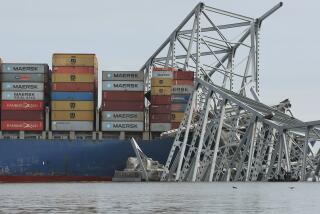A Glimpse of Yorktown Wreckage
- Share via
Fifty-six years after the carrier Yorktown sank in the battle of Midway--at a turning point of World War II--researchers Thursday released the first photograph of the wreckage three miles down on the Pacific Ocean floor.
A team of National Geographic researchers working with a San Diego-based U.S. Navy deep-sea exploration unit released a photograph of the carrier on the anniversary of the epic battle in 1942, when the Yorktown and four Japanese aircraft carriers were sunk during one of the most important sea battles of the 20th century. Robert Ballard, best known for his discovery of the Titanic in 1985, led the expedition.
Viewed through the video camera of the Navy’s Advance Tethered Vehicle, the giant ship appeared to be upright and well preserved in the darkness 16,650 feet below the surface.
Its four-barrel antiaircraft guns were still loaded and their muzzles still aimed skyward, Ballard said. The ship’s name was easily visible on the stern and its stainless steel surfaces were still shiny.
The sea pressure at such depths--a mile deeper than the Titanic came to rest--is so immense that the remote-controlled vehicle used to explore the site at one point imploded with the force of five sticks of dynamite, forcing Navy technicians to jury-rig repairs at sea.
“We had blown up our vehicle and we were in the middle of nowhere,” said Ballard, president of the Institute for Exploration in Mystic, Conn. “It was a mad scramble.”
Working from the U.S. Navy research ship Laney Choest, the National Geographic team used a new ocean floor mapping system developed by the University of Hawaii to locate the wreckage on May 19. The MR-1 mapper utilizes a portable side-scanning sonar to sweep broad swaths of ocean floor. After weeks of fruitless searches, the carrier first appeared as a smudge barely one-sixteenth of an inch long on the sonar image.
The actual exploration of the vessel, several hundred miles off Midway, was carried out by a deep-diving undersea robot craft, which can work at depths up to 20,000 feet. The craft is operated by the Navy’s submarine development group stationed at Point Loma.
The team had no trouble identifying the carrier by reading its name on the stern.
“What stands out in my mind the most is the bridge,” Ballard said Thursday. “We were able to look right in the bridge and see the wheel and the compass. To see the shiny doors and the camouflage paint, it looked like you could scrub it and it would be like it was 56 years ago.”
Poignancy of Discovery
Finding the sunken carrier held special significance for Navy historians. The Yorktown was one of three U.S. carriers left to defend the Pacific at the onset of World War II after the bulk of the American fleet was sunk at Pearl Harbor.
As part of a carrier task force, the Yorktown helped sink three Japanese carriers and severely damage a fourth during an abortive invasion of Midway. The Yorktown was heavily damaged by Japanese torpedoes and sank on June 7, 1942, three days after the battle began. It was last seen by the thousands of sailors who served aboard it as it rolled upside down and slipped beneath the waves.
The poignancy of the discovery was heightened by the presence on board the research vessel of American and Japanese veterans of the historic battle: an American sailor who jumped overboard to safety as the Yorktown sank, an American flier who survived the attack on the Japanese carrier Kaga and two Japanese pilots who served on the Kaga during the battle. Both were also veterans of the Japanese attack on Pearl Harbor.
The expedition robot left a memorial plaque by the wreck of the Yorktown. To memorialize the Kaga and its crew, the Japanese veterans also performed a Shinto ceremony near where the carrier was last seen.
The National Geographic Society put up $1.5 million for the expedition, in keeping with its long history of funding exploration activities.
Reflecting the intense public interest in Ballard’s exotic deep-sea explorations and commercial competitive pressures, the society is exploiting its newest historic discovery aggressively, skirting a line between scientific research and commercial entertainment.
In addition to a magazine article to be published next year, National Geographic also commissioned a two-hour documentary by its television division as well as a radio documentary by the Radio Expeditions Unit, which is a joint venture of National Public Radio and the magazine. The voyage also was documented with a series of electronic dispatches posted on the magazine’s Web site.
A formal news conference was held in Washington Thursday. Contrary to its usual practice, however, National Geographic required the researchers to withhold all but one of the roughly 1,000 still photographs taken of the sunken carrier, pending publication of the magazine feature.
Despite the publicity, Ballard said he is confident that the Yorktown will not attract commercial salvage operators and deep-sea souvenir hunters, as have the remains of the Titanic. The Yorktown site is secret and the wreckage belongs to the government.
“There is a big difference between the Yorktown and the Titanic,” Ballard said. “One is a warship, and a warship is forever the property of the country.”






